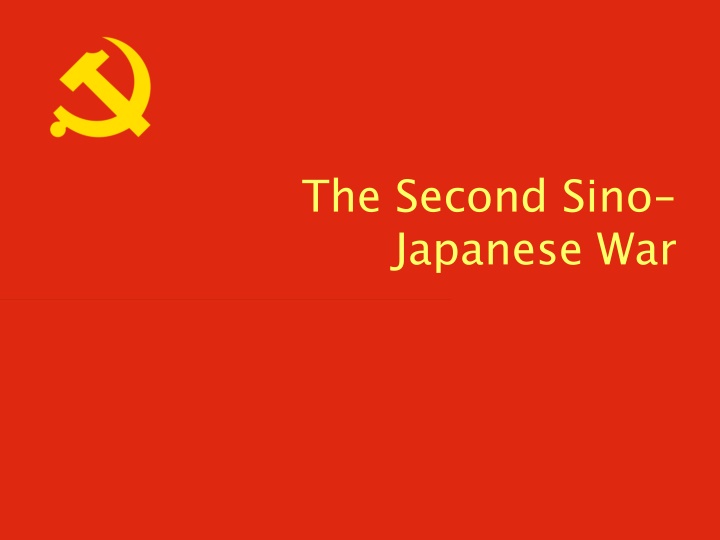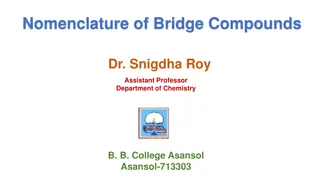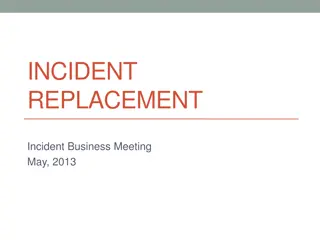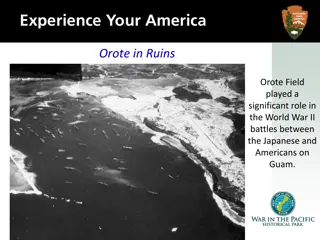The Second Sino-Japanese War and the Marco Polo Bridge Incident
The Second Sino-Japanese War, a conflict between Japan and China, and the Chinese Civil War between Communists and Nationalists are detailed. The invasion of Manchuria by Japan, Japan's establishment of Manchukuo, and the Marco Polo Bridge Incident are key events discussed. Tensions rise as Japan demands control, leading to the outbreak of conflict at the bridge. The struggle for control and influence over China unfolds amid political and military maneuvers.
Download Presentation

Please find below an Image/Link to download the presentation.
The content on the website is provided AS IS for your information and personal use only. It may not be sold, licensed, or shared on other websites without obtaining consent from the author.If you encounter any issues during the download, it is possible that the publisher has removed the file from their server.
You are allowed to download the files provided on this website for personal or commercial use, subject to the condition that they are used lawfully. All files are the property of their respective owners.
The content on the website is provided AS IS for your information and personal use only. It may not be sold, licensed, or shared on other websites without obtaining consent from the author.
E N D
Presentation Transcript
The Second Sino- Japanese War
JAPAN CHINA (prefix: Sino- ) Nanjing
The Chinese Civil War Dates: 1927-1936 and 1945-1950 War between Communists and Nationalists for control of China Interrupted by Japanese invasion and WWII
Communists and Nationalists Chinese Communist Party (CCP) Goals: reunify China; start socialist revolution Leader: Mao Zedong Kuomintang (KMT) Goals: reunify China; establish republic Leader: Chiang Kai- shek
Japan Invades 1931: Japan invades Manchuria KMT ignores the Japanese to focus on the Communists Japan establishes a puppet state called Manchukuo
Now who wants China? 1. Communists 2. Nationalists 3. Japan
Marco Polo Bridge Incident
Marco Polo Bridge Incident After the invasion and occupation of Manchuria in 1931, in the following years Japan had expanded its invasion and occupation of the northeastern part of China, essentially controlling all areas north, east and west of Beijing. Marco Polo Bridge is a bridge just outside of Beijing in the southwest direction next to the town Wanping. It has strategic importance because the Pinghan Railway that links Beijing and the Chinese Nationalist-controlled parts of China south of Beijing passed by this bridge. Prior to 1937, Japan had repeatedly demanded that all Chinese military forces be withdrawn from this area even though this is territory belonging to China! Japan had also attempted to purchase nearby land to build an airfield. All these attempts were refused by the Chinese, because if Japan had control of this bridge and the nearby area, then Beijing would be completely isolated from the Nationalist-controlled south.
Shortly before July 7, 1937, Japan had carried out intensive military training exercises in the vicinity of Marco Polo Bridge. These exercises were held every night, and these exercises greatly alarmed the local Chinese forces. On July 7, the Japanese army telegraphed the Chinese Nationalist forces stating that a Japanese soldier was missing and believed to be hiding inside the town of Wanping, and demanded that the Japanese army be allowed to enter the town of Wanping to search for the missing soldier. This request was denied by the Chinese army, although China responded that Chinese troops would conduct a search with an attached Japanese officer. Then Japan sent an ultimatum that Japanese troops must be allowed to enter the town within the next hour or the town would be fired upon. Around midnight, Japanese artillery started bombarding the town and shortly afterward, their infantry with tanks marched across the bridge. After a seesaw battle of advances and retreats, the two sides agreed to negotiate. After several days of negotiation but before the two sides were able to reach an agreement, Japan launched a full-scale attack on Wanping and Beijing. Just before they were surrounded by the Japanese army, the Chinese Nationalist army retreated from Beijing to the south. Beijing fell to the Japanese on July 29, and the nearby city of Tianjin fell on July 30; this led eventually to the control by the Japanese of the North China Plain by the end of 1937.
The exact details and sequence of events of the Marco Polo Bridge Incident may be subject to some debates, e.g., was a Japanese soldier really missing, who fired the first shot, when and how did the negotiation break down? However, there should not be any ambiguity in understanding why it happened and the motive behind it. After all, Japan had invaded and occupied a large part of China and set up various puppet governments. Japan had demanded and obtained all kinds of concessions from China, including stationing in China a significantly larger number of troops than granted to any other foreign power, conducting threatening, large-scale military manoeuvres on Chinese soil, and demanding that Chinese forces be withdrawn from strategic Chinese territories. If one takes into account this background information, then it should be crystal clear that the Marco Polo Incident was nothing more than an excuse to invade further into China, including occupying Beijing, Tianjin, and south of those cities.
After the Marco Polo Bridge Incident, major fighting began on a continuous basis between China and Japan. This continued for eight painful and horrifying years, including the Nanking Massacre, and the deaths of over 20 million Chinese, more than 75% of these were civilian deaths, and the additional wounding of over 10 million Chinese, again with the large percentage being civilians. This Eight-Year War of Resistance also weakened significantly the Japanese army, killing more than half a million and wounding several hundred thousands. It was also a morale booster, because Japan had claimed that they would be able to conquer China in three months. The fact that more than a million Japanese soldiers were tied down in China for many years definitely affected in a negative way the ability of the Japanese to carry out its war in the Pacific and other parts of Asia, thus helping to shorten WWII. It is important to remember this part of history, especially when the conservative segments of Japan deny many of the happenings of the Second Sino-Japanese War and try to position Japan as being the victim, rather than the aggressor. We should keep in mind the quote from the Spanish American philosopher George Santayana Those who cannot learn from history are doomed to repeat it.
The Second United Front Date: 1937-1945 Communists and Nationalists unite to drive out the Japanese Nationalists do most of the fighting; Communists take time to regroup
Second Sino-Japanese War Date: 1937-1945 Japan rapidly advances Chiang s strategy: trading space for time 1940: stalemate 1945: Japan surrenders in WWII and withdraws from China
The Nanjing Massacre Date: 1937 Japanese troops slaughter 300,000 Chinese civilians, mostly women and children, in Nanjing Widespread rape estimated 20,000 The Rape of Nanjing
The Nanjing Massacre Following a bloody victory in Shanghai during the Sino-Japanese War, the Japanese turned their attention towards Nanking. Fearful of losing them in battle, Nationalist leader Chiang Kai-Shek ordered the removal of nearly all official Chinese troops from the city, leaving it defended by untrained auxiliary troops. Chiang also ordered the city held at any cost, and forbade the official evacuation of its citizens. Many ignored this order and fled, but the rest were left to the mercy of the approaching enemy.
The Nanjing Massacre A small group of Western businessmen and missionaries, the International Committee for the Nanking Safety Zone, attempted to set up a neutral area of the city that would provide refuge for Nanking s citizens. The safety zone, opened in November 1937, was roughly the size of New York s Central Park and consisted of more than a dozen small refugee camps. On December 1, the Chinese government abandoned Nanking, leaving the International Committee in charge. All remaining citizens were ordered into the safety zone for their protection. ARRIVAL OF THE TROOPS On December 13, the first troops of Japan s Central China Front Army, commanded by General Matsui Iwane, entered the city. Even before their arrival, word had begun spreading of the numerous atrocities they had committed on their way through China, including killing contests and pillaging. Chinese soldiers were hunted down and killed by the thousands, and left in mass graves. Entire families were massacred, and even the elderly and infants were targeted for execution, while tens of thousands of women were raped. Bodies littered the streets for months after the attack. Determined to destroy the city, the Japanese looted and burned at least one-third of Nanking s buildings.
The Nanjing Massacre Though the Japanese initially agreed to respect the Nanking Safety Zone, ultimately not even these refugees were safe from the vicious attacks. In January 1938, the Japanese declared that order had been restored in the city, and dismantled the safety zone; killings continued until the first week of February. A puppet government was installed, which would rule Nanking until the end of World War II. AFTERMATH OF THE MASSACRE There are no official numbers for the death toll in the Nanking Massacre, though estimates range from 200,000 to 300,000 people. Soon after the end of the war, Matsui and his lieutenant Tani Hisao, were tried and convicted for war crimes by the International Military Tribunal for the Far East and were executed. Anger over the events at Nanking continues to influence Sino-Japanese relations to this day. The true nature of the massacre has been disputed and exploited for propaganda purposes by historical revisionists, apologists and Japanese nationalists. Some claim the numbers of deaths have been inflated, while others have denied that any massacre occurred.
Control Group & Imperial Way Led by Ugaki Kazushige they opposed the ultra-nationalist ideology of the Imperial Way faction. A mixture of Army Officers and soldiers who believed that the development of a technology driven army would guarantee Japanese expansionism Controlled most of the Japanese Army from 1920-1945. He was more prepared to cooperate with the west understanding spheres of influence.
Cont/d Imperial Way faction An ideology and group which developed in Japanese Government, Army and Business through the 1930s. They were ultra-nationalists who believed in the racial superiority of Japan over her Asian neighbours, her manifest destiny to remove European influence in East Asia and to expand the Japanese Empire into continental Europe Araki Sadao was the leader of this faction and he believed in mental toughness and physical discipline. They were involved in two coups against the Government both of which failed (1931 and 1936) and in the latter assassinated PM Saito Makoto
Anti-Comintern Pact An agreement first concluded between Nazi Germany and Japan in Nov 1936 and then with Fascist Italy added in November 1937. It was aimed against the USSR and its alleged ambitions and work in spreading global communism. This was influenced by the outbreak of the Spanish Civil War in June 1936 and USSR alliance with the Republican forces.























